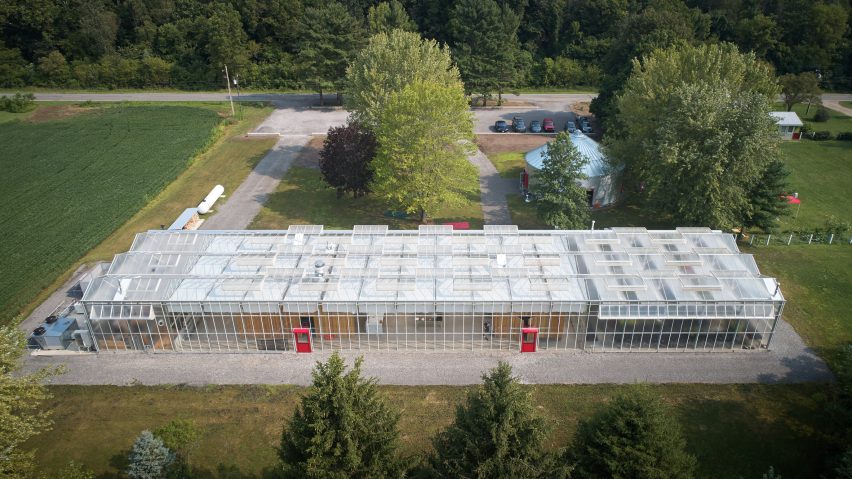Wheeler Kearns Architects has completed a multipurpose greenhouse for an organic farm in Michigan to host meals and events, grow produce and host classes.
The project was completed for Granor Farm, which is located in southern Michigan. According to the architects, it is the first certified organic vegetable farm in southwestern Michigan.
The business acquired a neighbouring lot and wanted to expand its operation to host dinners prepared with food grown onsite.
"Granor’s expansive kitchen will support its food and bakery production made from ingredients grown on the farm," said Chicago-based studio Wheeler Kearns.
The new greenhouse building spans 7,336 square feet (681 square metres) and is divided into three zones that offer a range of temperatures, humidity levels and uses.
Either end of the space is reserved for growing food. On the west side is a herb garden, while the eastern end of the building contains general-purpose planting beds.
"In the eastern and western zones, which include an experimental garden and space for production seedling and germination, translucent glass and automated venting provide the ideal growing environment," the architect studio explained.
The middle of the space is used to host meals and events. It is mostly open, allowing for a variety of furniture arrangements based on the farm's needs.
"The space [can] easily transform from a production facility to a place for community and dining," said Wheeler Kearns.
In mixed-use living and dining area, the exterior glass is completely clear, offering views of the surrounding farm.
"Farm staff, cooks, Farmcamp campers, visitors and diners are fully immersed in the working vegetable farm, learning about the food they are eating while nurtured by the sight and smells of the farm that surround them," said Wheeler Kearns.
Within the larger volume, functional spaces such as the kitchen, office and restrooms were laid out in and around wood-clad volumes that help break up the space and contrast the glass-and-steel construction of the greenhouse.
"Two wood-clad volumes are inserted to provide separation between the zones," the architecture studio explained.
Most of the required mechanical equipment was concealed under the polished concrete floor, so that the space has an open and unobstructed feeling. The flooring provides radiant heating during Michigan's cold winter months.
Adjacent to the structure the studio converted a conventional grain bin. The circular shape with aluminium exterior and wood interiors was designed for use for programs such as a farm camp for children.
Wheeler Kearns has been working on the masterplan of the property for more than a decade, including renovations and restorations of an existing farm house and the construction of vehicle sheds.
Other projects by the Chicago-based studio include an art-filled penthouse in the city centre that was built for a couple of collectors, and a home on the shores of Lake Michigan made up of a cluster of gabled volumes.
The photography is by Steve Hall unless otherwise stated.
Project credits:
Architect: Wheeler Kearns Architects (Dan Wheeler, FAIA - Principal; Michael Kendall, AIA – Project Architect; Thomas Boyster, AIA – Architect)
Structural engineer: C.E. Anderson & Associates, P.C
Landscape architect: McKay Landscape Architects
MEP/FP/engineer: Mansfield Engineering (Shawn Mansfield), Building Engineering Systems
Structural engineer: C.E. Anderson & Associates, P.C
Lighting design: Lux Populi

